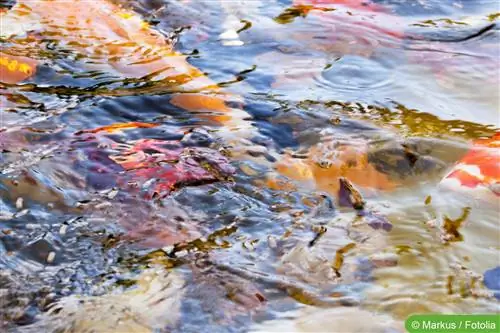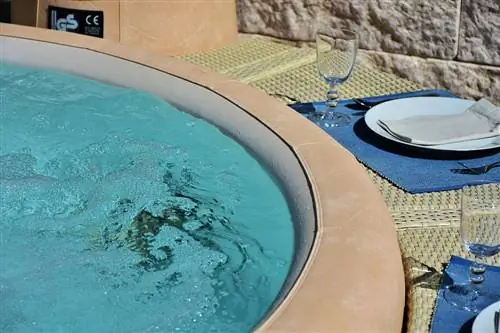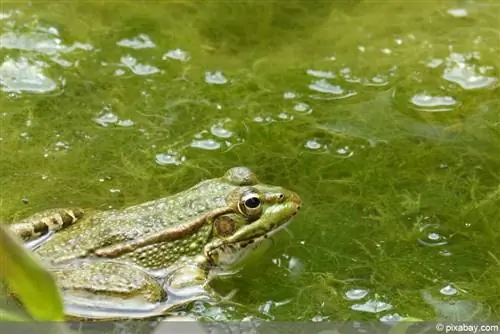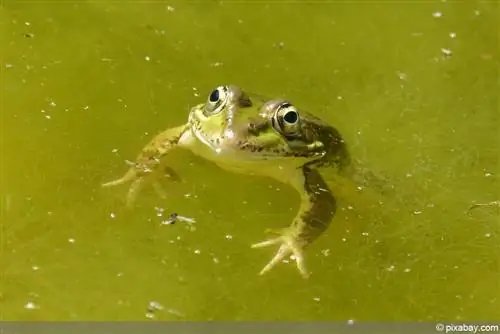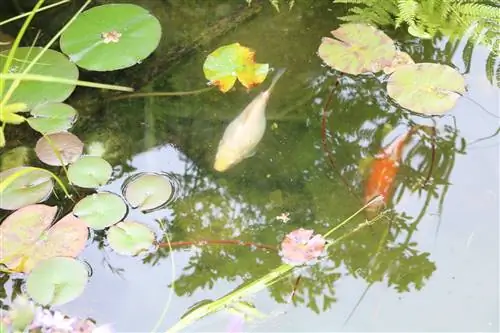- Author admin [email protected].
- Public 2023-12-17 03:39.
- Last modified 2025-01-24 12:45.
A green garden pond not only looks dirty and unsightly, but is also not a he althy habitat for fish and plants. Once the garden pond is cloudy, it is difficult to clear it again without chemical treatment and thus create a habitat in which plants and animals feel comfortable.
Planning a garden pond
If you are just planning the pond on your property, you can make an important contribution to clean and clear water right from the design stage. There are various external influences that affect the water color and the formation of algae in the pond and thus influence the pond climate. These include:
- the size
- the depth
- the location (sun, partial shade, shade)
- the bank design
- the substrate.
It is best to choose a new garden pond in a location where there is not full sunlight. Sun promotes the growth of algae and can be considered the main cause when the water turns green. But the ground and the bank design also have an influence. If dead plant parts fall into the pond and rot there, this will cloud the water and can also lead to an unpleasant smell. A large and deep garden pond generally stays clean longer and does not grow algae as quickly as a pond that cannot become a natural biotope due to its small size. For small ponds, it is often necessary to include a pump and a filter to ensure constant water treatment. Very large ponds work well without any aids and can be created as purely natural ponds in the garden.
Clear water in the garden pond through proper care
When the water is green and cloudy, many gardeners immediately resort to using chemicals to keep the water in their garden pond clear. But this is unnecessary because with the right care, any problem can be de alt with. Two no-go’s in pond care are:
- the complete water change
- chemical additives against algae growth and bacterial blooms.
In order to avoid clouding of the water, the gardener can work with very simple means and his pond:
- stock with lots of plants
- Use floating plants to shade the water
- prefer a low fish population
- Don’t feed fish excessively
- regular removal of algae pads
- Use a circulation pump for larger ponds
- shading the pond.
As a rule, it is not very time-consuming if you want to keep the water in the garden pond clear and avoid it becoming green or milky. It should be noted that a smaller pond requires more work than a larger pond. A biotope automatically forms in a large and deep garden pond, which cleans itself and therefore requires less time from the gardener. The small pond, on the other hand, becomes cloudy more quickly because the water heats up enormously in summer and thus promotes the formation of algae.
Detect and fix problems
Attention is an important aspect for the gardener. A garden pond does not become green and cloudy overnight, but rather shows clear signs before it becomes cloudy. A garden pond is not a pool with blue water that invites you to swim. Nevertheless, the water can be kept clear and transparent, rather than milky, cloudy or green. The silt from dead plant parts that collects on the ground is considered a breeding ground for microorganisms and a food source for fish. To a certain extent, the mulch on the bottom is considered necessary and important for life in the pond. But if it gets out of hand, the water changes color and the water can even tip over. If this happens, a foul and putrid smell will emanate from the garden pond. The following details indicate too much silt on the pond bottom and poor water quality:
- mulchy layer on the edges of the pond
- Strikingly poor growth or death of pond plants
- low feed intake of the fish
- Stay away from insects and water fleas
- viscous water quality
- no view of the pond bottom possible.
If one or more of these problems occur, the gardener should act quickly. With a landing net, all impurities floating in the pond can be removed and algae cushions can be skimmed off. Partial water removal and removal of the excessive layer of silt on the bottom will help clean the pond and ensure a he althy pond by replenishing new water.
Design for clear water in the garden pond
The bank and bottom design in the pond is not only a detail for the eye of the beholder, but also an opportunity for the gardener to avoid clouding the water. If you want to keep the water clear and clean, instead of green and cloudy, you should only focus to a limited extent on the natural substrate after excavation. You can also redesign an existing garden pond to ensure clean water, a he althy habitat for plants and animals, and a beautiful sight in the garden. Even small steps improve the water quality and beautify the garden pond:
- Lay the floor with pond liner
- Design edges with coarse pebbles
- Pruning pond plants
- Clean the surface regularly and skim off floating mud and duckweed with the landing net
- Choose bank plants with shading
- Do not change water too frequently.
It cannot always be avoided that algae form in the water and cause cloudy water quality. However, the gardener can act early and take precautions even when algae form is marginal, so that the water remains clear and does not become completely cloudy in the first place.
A garden pond that does not use any chemicals at all develops best. A pump for more oxygen in the water is advisable, as oxygen-enriched pond water stays clear longer. If the pond is in a sunny place, the gardener can provide the necessary shading by planting the banks and aquatic plants on the surface and make an important contribution to clear water in the garden pond.
What you should know about clear water in your garden pond
If the garden pond suddenly turns greenish, the alarm bells should ring for every hobby gardener and pond lover. The most common cause is too much algae, which can form in summer and degenerate from day to day, so that the entire garden pond soon mutates into a greenish broth. But fortunately there is a solution to this problem, or several:
- The most natural of all solutions and the most convenient for you is the silver carp. It eats all kinds of algae and is particularly suitable for larger garden ponds.
- Algae killer, a mixture of minerals that are added to the water and make the algae disappear in a few weeks. This does not endanger other plants or even fish.
- An anti-algae spray also works in a similar way, but it works within a day. There is no poison involved here either. So you see: there are a lot of ways to get rid of green pond water without using any chemicals or other harmful substances.
- If you don't want to rely on this and would rather take matters into your own hands, then there is a device available from specialist retailers that can also combat the green soup in the garden pond. The so-called water clarifier.
It works with UV (UV-C water clarifier) and is becoming increasingly popular among garden pond owners. The way it works is very simple: the water in the pond is illuminated with UV light, after which all the algae die and can be easily removed. The advantages of this water clarifier: It is not very expensive to purchase, it works very effectively and removes algae not just for a short time, but permanently and it is easy to use.

